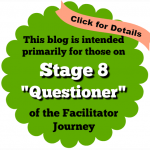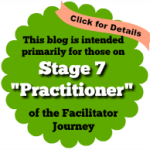“A Hero’s Journey” – A Model to Help Groups Through Big Change


 Recently, I had the pleasure of being reminded of a model that I think serves facilitators and their groups well. It is Joseph Campbell’s “Hero’s Journey”. I was co-facilitating a plenary session with my dear ICA colleague, Jo Nelson who works with ICA Canada. She had the idea of using the theme of the Hero’s Journey to help a large gathering of our colleagues synthesize our work from the previous days conference. It is such a beautiful model and it was so meaningful to me I’d like to share it with you.
Recently, I had the pleasure of being reminded of a model that I think serves facilitators and their groups well. It is Joseph Campbell’s “Hero’s Journey”. I was co-facilitating a plenary session with my dear ICA colleague, Jo Nelson who works with ICA Canada. She had the idea of using the theme of the Hero’s Journey to help a large gathering of our colleagues synthesize our work from the previous days conference. It is such a beautiful model and it was so meaningful to me I’d like to share it with you.
If you have seen the movie Star Wars, that is the Hero’s Journey that the main character Luke goes on. The essence of the Hero’s Journey is that we are sometimes “called to a difficult adventure” and when we are first called, we resist. But sometimes we have no choice and so we start the journey with fear and in trepidation. We cross the threshold and set off on our “departure”. (1st stage of the journey)
I n the second part of the Hero’s Journey, we encounter many challenges and trials. We may get tempted away from our “true path”. We get a sense of our ability to succeed on occasion. In the final stage of the Journey, we are called to return. At first we may not want to come back from our adventure. But ultimately we do cross the threshold back into our old life but renewed and we become “masters of two worlds”. We have gone to the underworld and successfully returned – completely changed and victorious. This is my interpretation and an oversimplification of the Hero’s Journey yet it is obviously useful because we are often called as facilitators to take a group on a “Hero’s Journey”. If we are not aware of this we don’t choose the right interventions to take at each moment of the Journey. So below I explore briefly with you what you might do at some of the major stages to accompany and to facilitate a group through their Hero’s Journey.
n the second part of the Hero’s Journey, we encounter many challenges and trials. We may get tempted away from our “true path”. We get a sense of our ability to succeed on occasion. In the final stage of the Journey, we are called to return. At first we may not want to come back from our adventure. But ultimately we do cross the threshold back into our old life but renewed and we become “masters of two worlds”. We have gone to the underworld and successfully returned – completely changed and victorious. This is my interpretation and an oversimplification of the Hero’s Journey yet it is obviously useful because we are often called as facilitators to take a group on a “Hero’s Journey”. If we are not aware of this we don’t choose the right interventions to take at each moment of the Journey. So below I explore briefly with you what you might do at some of the major stages to accompany and to facilitate a group through their Hero’s Journey.
My own example:
First I’d like to give you a personal example which might remind you of your own many Hero’s Journeys – some of them much bigger than others. I hope you find my own example hopeful if you are in the midst of your own “call to adventure”. I had a car accident in 2009. I had no idea initially that the accident would have such a big impact in my life. I started experiencing headaches as a result of whiplash. I refused to believe that I was being called on a long adventure. What ensued was three years of painful searching for a cure to my 24/7 headaches. I had many allies along the way. I just recently realized when I did this facilitation with Jo that I had indeed experienced each phase of the Hero’s Journey over that 3+ year period. Since we were using the Hero’s Journey framework to facilitate a plenary session, I gave an example and then declared to the group that I had indeed emerged from “the other world” and I was fully back – “master of two worlds”. Since many of the audience had known me both before and during this dark period of my life. My colleagues applauded in the spirit of celebration of my return 🙂 I offer to any of you who are in the midst of, or about to begin your call to the adventure, that this is a precious time and you most likely will also resurface. Just pay attention and accept all the stages of the journey and all the allies that come to support you in the journey. I know some of you are in the midst of this Journey and I’d like to let you know that I’m with you. In other words, you do not have to do this Journey alone! And our jobs as facilitators is to be one of their allies in their Journey.
Helping the Group
Now, back to what you do with a group that you suspect is at some point in one of the three phases of the Hero’s Journey, i.e. Departure, Initiation, Return.
1) Departure. Here are some things you may do to help the group recognize the call to adventure and take the first steps into the darkness called by Campbell as “The Belly of the Whale” and in the movie The Matrix, “The Torture Room”:
- Conduct a retrospective review of their history to help them see why they are where they are right now. From this they can consider what they want their future to l ook like. We have a module on how to do this called “Looking Back to Move Forward”. It comes from The Institute of Cultural Affairs (ICA) and is known as The Historical Scan or Wall of Wonder. You can purchase a sticky wall to help you facilitate this process.
- Conduct a reflective conversation with them that acknowledges what they’ve been through and what are the implications of not changing.
- Explore recent internal and external trends using a trend analysis tool. This will help them understand the forces around them that are calling them to cross the threshold (i.e. start the journey).
2) Initiation. If you are helping a group that has already entered the journey and they are discouraged by the difficulty of the journey or they are distracted from the clear path they need to be on, consider the following processes:
- Be a cheerleader for them. You could have them celebrate small successes.
- Hold an honest, authentic discussion with them that reminds them of their mission and their shared future vision.
- Towards the end of their “initiation” in this journey and before they “return”, have them do skits, songs or some dramatic representation of the journey they have taken. See our module “Three S’s for Peak Team Performance”. This is also an ICA tool that is absolutely fantastic for boosting morale and reminding a group of their resilience and creativity.
3) Return. This is the last stage of the Hero’s Journey. The tendency is for the group to want to stay in the underworld and keep fighting yet more challenges. Your job is to help them to decide to return and acknowledge their victory and their new found ability to handle future similar “dark phases” of their organizational life. Things you might consider doing in this phase:
- Brainstorm all of their accomplishments followed by a series of reflective questions that help them understand that and get back to their original mission.
- Offer a Forcefield Analysis looking at all of the pros of continuing what they have been doing versus acknowledging they have done enough and it is time to move on.
- Action plan – help them articulate the next new phase in terms of a concrete victory and specific accomplishments to get to that victory. We have a great process to do this that is included in our 2 Day ToP Facilitation Methods course. This same course is offered all over the USA.
If you’re curious about more on this, I recommend Campbell’s book The Hero with a Thousand Faces (1949). This book provides examples from cultures all over the world and demonstrates that all stories have the same pattern which he called Hero’s Journey. This website link is an overview of Campbell and Jung’s contribution to this concept and compares Campbell’s model to the two movies Star Wars and The Matrix, www.moongadget.com/origins/myth.html. Carl Jung also talked about this myth in terms of “archetypes”. Jung believed that everyone is born with a basic subconscious concept of a hero. This explains why people from many cultures enjoy the same types of stories. For those of you who know Cirque du Soleil, every performance is a Hero’s Journey. Here are a couple of YouTube links that we showed in our recent facilitation that you might really enjoy.

